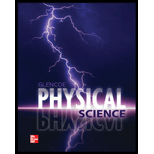
Concept explainers
The evidence that seismic waves transfer energy without transferring matter.
Answer to Problem 3R
The movement of crust along faults as seismic waves travel away is the evidence.
Explanation of Solution
Introduction:
Seismic waves are also called energy waves. They result in volcanic eruptions, earthquakes etc.
There is no transfer of matter in seismic wave because these waves travel away from the faults. The crust moves along the fault when the seismic waves travel away. This is the evidence that seismic waves transfer energy without transferring matter.
Conclusion:
Thus, the movement of crust along faults as seismic waves travel away is the evidence.
Chapter 9 Solutions
Glencoe Physical Science 2012 Student Edition (Glencoe Science) (McGraw-Hill Education)
Additional Science Textbook Solutions
Chemistry: The Central Science (14th Edition)
Anatomy & Physiology (6th Edition)
Human Physiology: An Integrated Approach (8th Edition)
Genetic Analysis: An Integrated Approach (3rd Edition)
Applications and Investigations in Earth Science (9th Edition)
Organic Chemistry (8th Edition)
- T1. Calculate what is the received frequency when the car drives away from the radar antenna at a speed v of a) 1 m/s ( = 3.6 km/h), b) 10 m/s ( = 36 km/h), c) 30 m /s ( = 108 km/h) . The radar transmission frequency f is 24.125 GHz = 24.125*10^9 Hz, about 24 GHz. Speed of light 2.998 *10^8 m/s.arrow_forwardNo Chatgpt please will upvotearrow_forwardNo Chatgpt please will upvotearrow_forward
- No Chatgpt pleasearrow_forward3. A measurement taken from the UW Jacobson Observatory (Latitude: 47.660503°, Longitude: -122.309424°, Altitude: 220.00 feet) when its local sidereal time is 120.00° makes the following observations of a space object (Based on Curtis Problems 5.12 + 5.13): Azimuth: 225.00° Azimuth rate: 2.0000°/s. Elevation: 75.000° Elevation rate: -0.5000°/s Range: 1500.0 km Range rate: -1.0000 km/s a. What are the r & v vectors (the state vector) in geocentric coordinates? (Answer r = [-2503.47 v = [17.298 4885.2 5.920 5577.6] -2.663]) b. Calculate the orbital elements of the satellite. (For your thoughts: what type of object would this be?) (Partial Answer e = 5.5876, 0=-13.74°) Tip: use Curtis algorithms 5.4 and 4.2.arrow_forwardConsider an isotope with an atomic number of (2(5+4)) and a mass number of (4(5+4)+2). Using the atomic masses given in the attached table, calculate the binding energy per nucleon for this isotope. Give your answer in MeV/nucleon and with 4 significant figures.arrow_forward
- A: VR= 2.4 cm (0.1 V/cm) = 0.24 V What do Vector B an C represent and what are their magnitudesarrow_forward4. Consider a cubesat that got deployed below the ISS and achieved a circular orbit of 410 km altitude with an inclination of 51.600°. What is the spacing, in kilometers, between successive ground tracks at the equator: a. Ignoring J2 (Earth's oblateness) effects b. Accounting for J2 effects c. Compare the two results and comment [Partial Answer: 35.7km difference]arrow_forwardplease solve and explainarrow_forward
 College PhysicsPhysicsISBN:9781305952300Author:Raymond A. Serway, Chris VuillePublisher:Cengage Learning
College PhysicsPhysicsISBN:9781305952300Author:Raymond A. Serway, Chris VuillePublisher:Cengage Learning University Physics (14th Edition)PhysicsISBN:9780133969290Author:Hugh D. Young, Roger A. FreedmanPublisher:PEARSON
University Physics (14th Edition)PhysicsISBN:9780133969290Author:Hugh D. Young, Roger A. FreedmanPublisher:PEARSON Introduction To Quantum MechanicsPhysicsISBN:9781107189638Author:Griffiths, David J., Schroeter, Darrell F.Publisher:Cambridge University Press
Introduction To Quantum MechanicsPhysicsISBN:9781107189638Author:Griffiths, David J., Schroeter, Darrell F.Publisher:Cambridge University Press Physics for Scientists and EngineersPhysicsISBN:9781337553278Author:Raymond A. Serway, John W. JewettPublisher:Cengage Learning
Physics for Scientists and EngineersPhysicsISBN:9781337553278Author:Raymond A. Serway, John W. JewettPublisher:Cengage Learning Lecture- Tutorials for Introductory AstronomyPhysicsISBN:9780321820464Author:Edward E. Prather, Tim P. Slater, Jeff P. Adams, Gina BrissendenPublisher:Addison-Wesley
Lecture- Tutorials for Introductory AstronomyPhysicsISBN:9780321820464Author:Edward E. Prather, Tim P. Slater, Jeff P. Adams, Gina BrissendenPublisher:Addison-Wesley College Physics: A Strategic Approach (4th Editio...PhysicsISBN:9780134609034Author:Randall D. Knight (Professor Emeritus), Brian Jones, Stuart FieldPublisher:PEARSON
College Physics: A Strategic Approach (4th Editio...PhysicsISBN:9780134609034Author:Randall D. Knight (Professor Emeritus), Brian Jones, Stuart FieldPublisher:PEARSON





